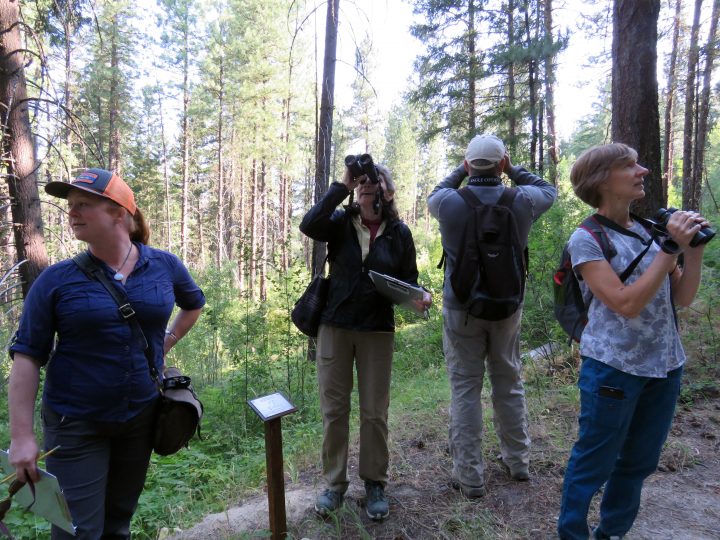Chelan-Douglas Land Trust
Why Bird Conservation?
Executive Director Curt Soper explains, “Chelan-Douglas Land Trust’s conservation work is an integrated system of well- managed, protected lands–from neighborhood trailheads to pristine floodplains–for people to use and enjoy, and for important natural systems to thrive.” The Chelan-Douglas Land Trust (CDLT) strives for a thoughtful, balanced approach to land use, conservation, and stewardship to ensure that our communities thrive compatibly within the limits of natural ecological systems. Several CDLT properties are popular bird-watching destinations that are easy to access and very close to the 50,000 people in the Wenatchee Valley urban area. The CDLT has identified the greater birdwatching community as future members and conservation partners and is a founding partner for a local bird festival.
Spotlight Resource: Leavenworth Spring Bird Fest
2017 marked the 14th annual four-day Leavenworth Spring Bird Fest celebrating the return of migratory birds in the midst of peak wildflower season while enjoying field trips, events and free family activities for all ages and abilities in Leavenworth, Washington and throughout the Wenatchee River valley. Annually, several hundred people attend, most traveling east over the Cascade Mountains from the Seattle area. For a decade, CDLT’s Stewardship Director, Neal Hedges, and Conservation Fellow, Susan Ballinger, have teamed up to lead walks on two of the CDLT’s properties. In May 2017, at the forested Mountain Home Preserve, Neal’s keen ear detected both Warbling and Cassin’s vireos singing side-by-side in the Ponderosa pine canopy as well as 32 other species. The prior morning at Horse Lake Reserve in shrub-steppe habitat, the group delighted in a first-ever sighting of a Rock Wren as they listened to singing Lazuli Buntings and Lark Sparrows. Susan later entered 45 species into the eBird hotspot for this location.
Citizen Science eBird Project Launch
Neal is responsible for habitat stewardship on these two properties, both of which are within important wildlife migration corridors. Neal recognized the need to monitor bird species use as an important indicator of overall habitat quality, but his available time was limited to the annual bird festival trips.
Neal and Susan hatched the idea to turn the bird festival routes into a citizen project, using eBird. Neal determined stationary count locations demarked by permanent posts. A local high school metal arts class fabricated aluminum plates with engraved eBird logos, affixed to metal posts. A few months later, a wildfire swept across the Horse Lake Reserve, reducing the dense shrubby thickets of elderberry, wild rose, and snowberry to stubble. How long would it take for the ravine shrubs to regrow and again provide habitat for nesting neotropical migratory songbirds?
The value of citizen science data collection hit home. The need for on-going monthly surveys at Horse Lake Reserve in the fire-prone sagebrush grasslands became a practical way for the CDLT to monitor post-fire adaptive management practices. At Mountain Home, Neal is preparing a fall 2017 forest thinning project designed to restore a pre-settlement open ponderosa-pine forest. Having pre-treatment bird survey data will allow CDLT to monitor the effect of the forest health improvement project by comparing bird use before and after treatment.

With the creation of her Conservation Fellow staff position in 2016, Susan began on-going monthly eBird surveys, April-November, at both properties. CDLT also wanted to build new connections with local bird enthusiasts, as a way to cultivate future eBird route volunteers. Susan has offered workshops designed to introduce eBird and leads on-going monthly outings to introduce people to using eBird in the field. The CDLT invites volunteers to join staff on scheduled monthly eBird project surveys at Mountain Home and Horse Lake. Having extra pairs of eyes and ears increases the accuracy of the data and is a skill-building opportunity for volunteers.
CDLT set a 2017 goal to post clearly written protocol instructions and maps on their website, accessible to any visiting birder who is willing to collect and share data using eBird. CDLT reached out to Land Trust Project Leader, Sara Barker for protocol review. Sara recommended also working with Cornell’s Marshall Illif who helped standardize the names and locations of eBird hotspots on Trust properties. A milestone was reached in June 2017, when two individual volunteers successfully implanted the protocols in the field and shared their eBird data. CDLT now proudly hosts a Community Science webpage with links to all needed field forms and maps.
Advice for Other Land Trusts
Other land trusts could consider incorporating standardized eBird routes into their existing lands to monitor environmental changes over time. Neal muses, “for CDLT, eBird route data provides valuable information I can use to inform my management decisions, and it allows skilled citizen scientists a rewarding volunteer experience that fits their own schedule.” Susan concludes that “offering eBird routes on our lands is allowing us to introduce a new community of birders to our work, effectively growing our land trust community through binocular lenses.”
Visit the Chelan-Douglas Land Trust Citizen Science webpage to view eBird project protocols and maps.
Hero image: CDLT Conservation Fellow, Susan, is joined by a citizen science volunteer, conducting the May, 2016 eBird protocol survey at Horse Lake Reserve. The ten-minute stationary count included western bluebird, American robin, yellow-rumped warbler, chipping sparrow, and spotted towhee. Photo credit: CDLT


